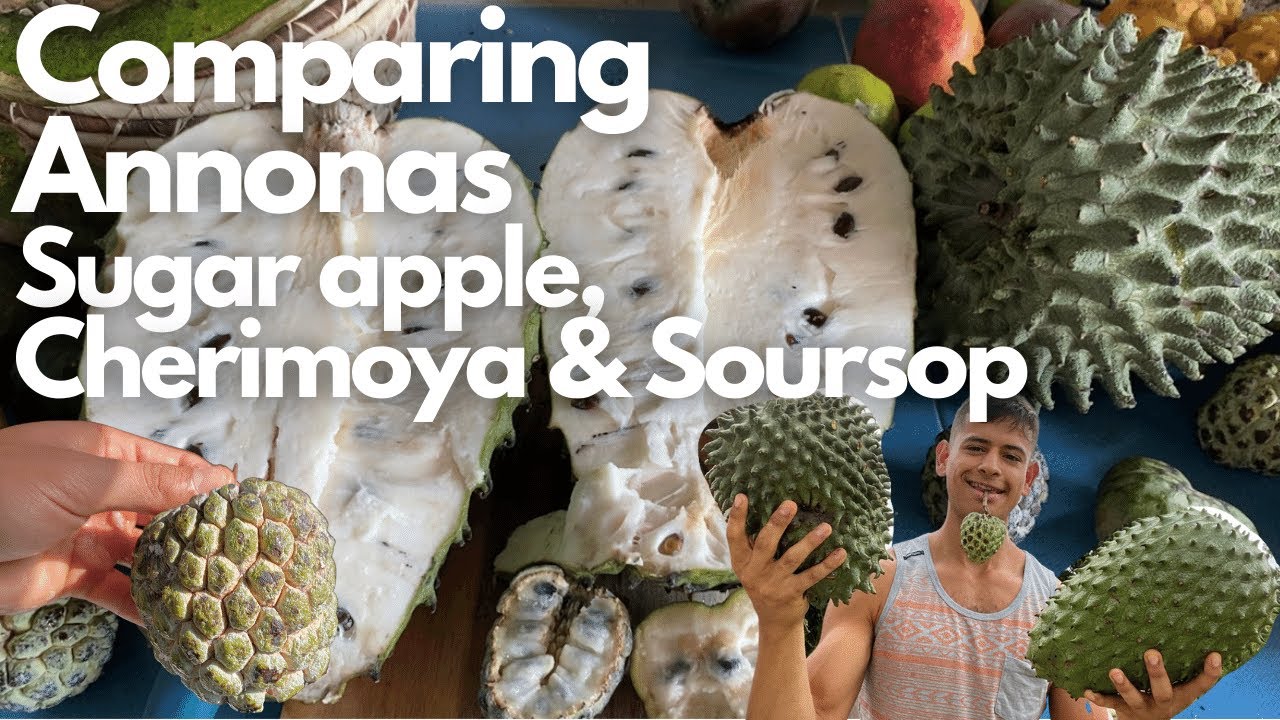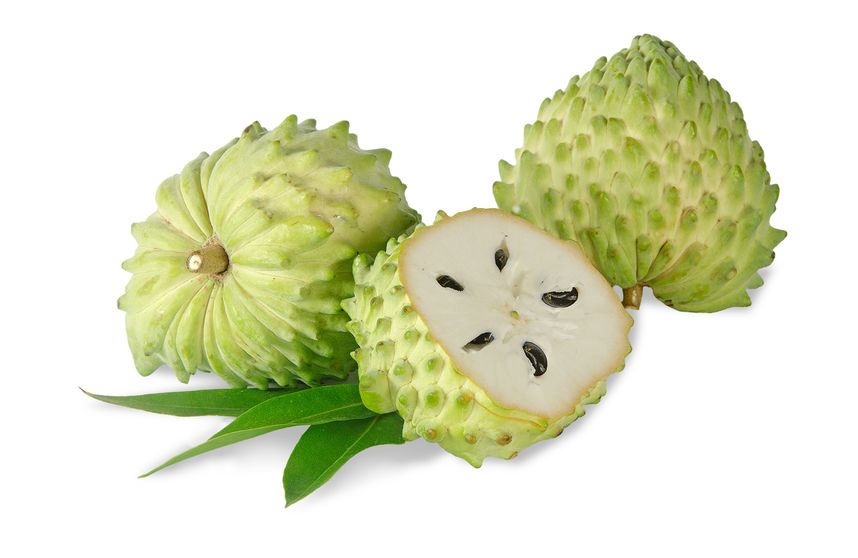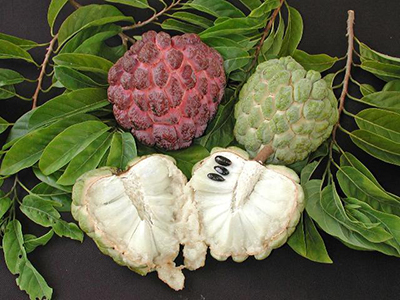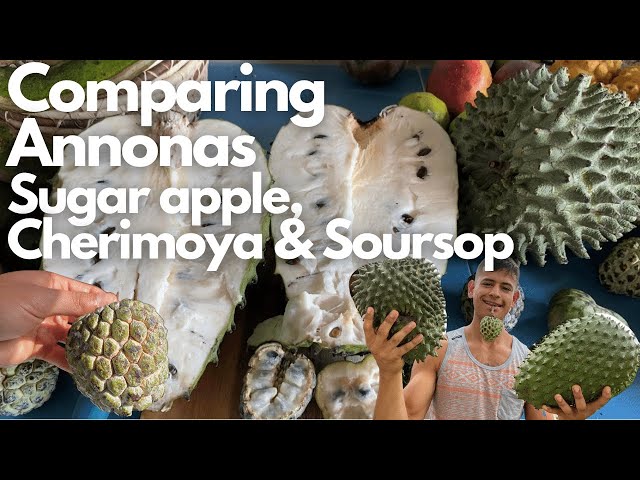What Is Soursop And Custard Apple?

Soursop and custard apple are two tropical fruits that are often compared due to their similar appearance and taste. Soursop, scientifically known as Annona muricata, is a fruit with a prickly green skin and creamy white flesh. It is known for its unique flavor, which is a combination of tangy and sweet with hints of pineapple and citrus. Custard apple, also known as Annona reticulata, has a spiky green exterior and a soft, creamy interior. It has a sweet and fragrant taste, similar to a combination of pear and banana. Both fruits are highly nutritious and offer a range of health benefits.
Overview Of Soursop Characteristics And Taste
Soursop, also known as Annona muricata, is a tropical fruit with distinct characteristics. It has a green, spiky exterior and creamy white flesh. The fruit can grow to a considerable size, up to 12 inches long and weighing several pounds. Soursop has a unique taste that is often described as a blend of tangy and sweet, with hints of pineapple and citrus. Its flavor profile makes it a popular choice for juices, smoothies, ice creams, and desserts. Soursop is also rich in nutrients, such as vitamin C, fiber, and antioxidants, making it a healthy addition to any diet.
Overview Of Custard Apple Characteristics And Taste
Custard Apple, also known as Annona reticulata, is a tropical fruit with distinct characteristics. It has a bumpy, greenish-yellow exterior and creamy white flesh. The fruit can vary in size from small to medium, typically about 4-8 inches in diameter. Custard Apple has a sweet and creamy taste, resembling a combination of banana, vanilla, and pear. Its texture is smooth and custard-like, hence the name. The fruit is often enjoyed fresh, but it can also be used in desserts, smoothies, and ice creams. Custard Apple is packed with essential nutrients such as vitamin C, fiber, and potassium. Link:
Health Benefits Of Soursop And Custard Apple

Soursop and Custard Apple are not only delicious tropical fruits but also offer various health benefits. Soursop is known for its high antioxidant content, which helps fight inflammation and oxidative stress. It is also rich in vitamin C, which boosts the immune system and supports collagen production. On the other hand, Custard Apple is packed with essential nutrients like vitamin C, fiber, and potassium. These nutrients contribute to a healthy heart, digestion, and immune system. Both fruits are a great addition to a balanced and nutritious diet.
Nutritional Value Of Soursop
Soursop is a nutrient-dense fruit that offers various health benefits. It is rich in vitamin C, providing 206mg per 100 grams, which supports a healthy immune system. Additionally, it contains 1g of protein, 17g of carbs, and 3.3g of fiber, which aids in digestion and promotes satiety. Soursop also contains small amounts of fat, with only 0.3g per 100 grams. With its low calorie content of 66 kcal, Soursop is a great addition to a balanced and nutritious diet. Its impressive nutritional profile makes it a valuable fruit for overall health and well-being.
Health Benefits Of Custard Apple
Custard Apple is packed with health benefits. It is a rich source of vitamin C, which helps boost the immune system and promote healthy skin. Additionally, it contains dietary fiber, which aids in digestion and helps prevent constipation. Custard Apple is also known to have antioxidant properties, which can help fight against harmful free radicals in the body. Furthermore, it is a good source of essential minerals like potassium and magnesium, which are important for maintaining heart health and regulating blood pressure. Including Custard Apple in your diet can contribute to a healthier overall lifestyle.
How To Eat Soursop And Custard Apple

To enjoy soursop, begin by cutting the fruit in half and scooping out the flesh with a spoon. You can eat it as is or make it into a refreshing juice by blending the flesh with some water and sweetening it if desired. Soursop is also commonly used in smoothies, ice creams, and desserts.
Custard apple can be eaten fresh by cutting it in half and scooping out the creamy pulp with a spoon. The seeds are not usually eaten and can be removed before consuming. Some people also use custard apple in salads, desserts, or make it into a smoothie.
Different Ways To Consume Soursop
Soursop can be enjoyed in various ways, making it a versatile fruit to incorporate into your diet. One common method is to simply cut the fruit in half and scoop out the flesh with a spoon. This allows you to enjoy the creamy texture and unique flavor of the fruit as is. Alternatively, you can blend the flesh with some water to create a refreshing Soursop juice. This juice can also be sweetened according to your preference. Soursop is also commonly used in smoothies, ice creams, and desserts, adding a tropical twist to your favorite treats.
Various Methods To Enjoy Custard Apple
Custard Apple can be enjoyed in various ways, making it a versatile fruit to add to your culinary repertoire. One simple method is to cut the fruit in half, scoop out the flesh with a spoon, and enjoy it as is. The creamy texture and sweet flavor make it a delightful treat on its own. For a unique twist, you can also use custard apple in smoothies, milkshakes, or ice creams, adding a tropical touch to your favorite desserts. Alternatively, you can blend the flesh to make a refreshing custard apple juice or incorporate it into custards and pies for a truly indulgent experience.
Soursop Vs Custard Apple: Taste Test

When it comes to taste, soursop and custard apple have distinct flavor profiles that set them apart. Soursop offers a unique combination of sweetness and tanginess, reminiscent of a blend of mango and pineapple. On the other hand, custard apple is known for its intense sweetness, with a flavor that resembles custard.
In a taste test, individuals may prefer soursop for its refreshing tropical taste and the zing it adds to their palate. Custard apple, with its luscious sweetness, may be favored by those who enjoy a truly indulgent and dessert-like experience.
Both fruits offer delightful tastes that cater to different preferences, making them versatile options for fruit enthusiasts.
A Comparison Of Flavor Profiles
When it comes to taste, soursop and custard apple have distinct flavor profiles that set them apart. Soursop offers a unique combination of sweetness and tanginess, reminiscent of a blend of mango and pineapple. On the other hand, custard apple is known for its intense sweetness, with a flavor that resembles custard. In a taste test, individuals may prefer soursop for its refreshing tropical taste and the zing it adds to their palate. Custard apple, with its luscious sweetness, may be favored by those who enjoy a truly indulgent and dessert-like experience. Both fruits offer delightful tastes that cater to different preferences, making them versatile options for fruit enthusiasts.
Texture And Aroma Differences
When it comes to texture, soursop and custard apple differ significantly. Soursop has fibrous white flesh that can be juicy and slightly grainy, giving it a more refreshing and crunchy texture. In contrast, custard apple has a creamy, smooth, and almost custard-like texture, which adds to its indulgent and dessert-like experience.
In terms of aroma, soursop produces a pleasant, tropical fragrance that is reminiscent of a blend of pineapple and banana. On the other hand, custard apple has a sweet and fragrant aroma, often likened to a mix of vanilla and ripe fruits. These differences in texture and aroma contribute to the distinct experiences offered by soursop and custard apple.
Culinary Uses And Recipes

Both soursop and custard apple offer versatile culinary uses and can be enjoyed in a variety of ways. Soursop is commonly used in smoothies, juices, ice creams, and sorbets due to its refreshing taste. It can also be added to salads or used as a topping for desserts. On the other hand, custard apple is often used in desserts such as custards, puddings, pies, and cakes. It can also be eaten fresh or blended into creamy milkshakes. These fruits provide a delicious and unique twist to your culinary creations.
Source:
Cooking With Soursop: Recipes And Ideas
Soursop, with its deliciously tangy flavor, is a versatile fruit that can add a unique twist to your culinary creations. One popular way to enjoy soursop is in smoothies or juices. Try blending soursop with coconut milk and a hint of sweetener for a tropical treat. You can also use soursop puree as a filling for pies, tarts, or cakes. For a refreshing dessert, create soursop sorbet by combining pureed soursop with sugar and lemon juice, then freezing it. The possibilities are endless when it comes to cooking with soursop! Source:
Custard Apple Culinary Applications And Dishes
Custard Apple, also known as sugar apple, has a uniquely sweet and creamy flavor that lends itself well to various culinary applications. One popular way to enjoy this fruit is by eating it fresh, scooping out the flesh and savoring it on its own. Custard Apple can also be used in desserts such as custards, cakes, and pastries, adding a delightful tropical twist. Additionally, it can be transformed into a flavorful ice cream or used as a topping for pancakes or waffles. The versatility of Custard Apple makes it a great ingredient to experiment with in a variety of sweet treats.
Conclusion

In conclusion, soursop and custard apple are two distinct tropical fruits that offer unique flavors and health benefits. While soursop is known for its sweet and tangy taste, custard apple boasts a creamy and delicate flavor. Both fruits are packed with essential nutrients and can be enjoyed in a variety of ways, whether eaten fresh or incorporated into recipes. So, whether you choose soursop or custard apple, you can’t go wrong with either choice for adding a tropical twist to your culinary adventures and enhancing your overall well-being.
Nutritional Comparison Between Soursop And Custard Apple
When it comes to nutritional content, both soursop and custard apple offer their own unique benefits. Soursop is rich in vitamin C, fiber, and antioxidants, which help boost immunity, promote healthy digestion, and protect against cell damage. On the other hand, custard apple is a good source of vitamin A, magnesium, and potassium, which support vision health, regulate blood pressure, and maintain proper muscle and nerve function. Both fruits are low in calories and fat, making them nutritious additions to a balanced diet. Ultimately, choosing between soursop and custard apple depends on your specific nutritional needs and preferences.
The Versatility And Availability Of Both Fruits
Both soursop and custard apple are versatile fruits that can be enjoyed in various ways. Soursop can be consumed fresh, blended into smoothies, or used as an ingredient in desserts and ice creams. Custard apple can be eaten as is, or used in pies, puddings, and jams. When it comes to availability, both fruits can be found in tropical regions such as Southeast Asia, South America, and the Caribbean. However, soursop tends to be more widely available in larger supermarkets and specialty fruit stores, while custard apple may be more commonly found in local markets or during its peak season. Overall, both fruits offer a delicious and nutritious addition to your diet.
FAQ About Soursop Vs Custard Apple: Tropical Fruit Face-off
Q: What is the main difference between soursop and custard apple?
A: The main difference lies in their appearance, taste, and nutritional content. Soursop has a spiky green skin with white flesh and a tangy flavor, while custard apple has a bumpy green skin with creamy white flesh and a sweet taste.
Q: Which fruit is more commonly found in tropical regions?
A: Both soursop and custard apple are popular tropical fruits, but soursop tends to be more widely available in markets and grocery stores compared to custard apple.
Q: Are there any health benefits associated with consuming soursop and custard apple?
A: Yes, both fruits are rich in antioxidants, vitamins, and minerals that can boost the immune system, aid digestion, and promote overall health. Soursop is known for its potential anti-cancer properties, while custard apple is valued for its heart-healthy benefits.
Q: Can soursop and custard apple be consumed in similar ways?
A: Yes, both fruits can be eaten raw, juiced, blended into smoothies, or used in desserts and beverages. Soursop is often used in traditional medicines and teas, while custard apple is commonly eaten as a standalone fruit or added to salads.
Q: Are there any concerns or precautions to consider when consuming soursop or custard apple?
A: It’s important to consume these fruits in moderation due to their natural sugar content. Some individuals may have allergies to soursop or custard apple, so it’s advisable to consult a healthcare provider before incorporating them into your diet.
Q: Do soursop and custard apple have any culinary uses beyond eating them fresh?
A: Yes, both fruits can be used to make jams, jellies, ice creams, and beverages. Soursop leaves are also used in cooking and herbal remedies, while custard apple seeds can be ground into a powder for various culinary applications.
Q: Which fruit is more versatile in terms of culinary applications?
A: Soursop is known for its versatility in both sweet and savory dishes, making it a popular choice for chefs and home cooks looking to experiment with tropical flavors. Custard apple, on the other hand, is primarily enjoyed on its own due to its unique taste and texture.

Salsas by Karoll’s Catering is a vibrant and innovative Canadian fusion family restaurant that welcomes you to indulge in a delightful culinary experience. Every Sunday, from 11 am to 2 pm, we invite you for a delicious brunch that will tantalize your taste buds. Whether you prefer dining in or taking out, we ensure that our delectable dishes are available to savour at your convenience. In addition to our enticing Sunday brunch, we host a lively happy hour every Thursday, Friday, and Saturday. During this time, you can enjoy discounted food items, get $2.50 off on beer, and sip on refreshing $5 margaritas. It’s the perfect opportunity to unwind and relish in the flavours of our Canadian fusion cuisine.